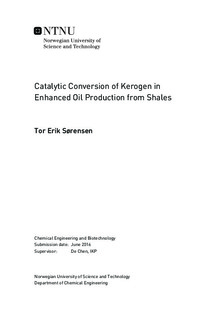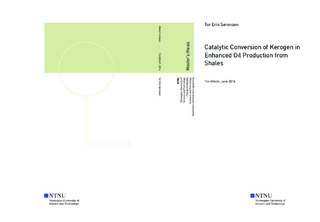| dc.description.abstract | Low oil prices, limited oil reserves and an anticipated increase in global energy demand calls for alternative sources of energy. Oil production from shales is an unconventional hydrocarbon source which is currently too expensive to utilize, and research in catalytic conversion may help reduce production cost. In this work, the catalytic effect of transition metal chloride salts on thermal upgrading of kerogen from Green River Formation oil shale has been investigated by TGA, SEM-EDS, XRF, EGA and pyrolysis-GC/MS. Catalytic performance has been observed as a reduction in the temperature for maximum conversion (Tmax) by evolved gas analysis (EGA). Of the metal chlorides tested zinc (ZnCl2) proved most effective, and by optimization based on reduction in Tmax an optimal Zn2+ loading of 10 wt% on decarbonated kerogen was determined, with a resulting Tmax reduction of 35 °C. Qualitative and quantitative analysis by Pyrolysis-GC/MS determined a catalytic cracking effect, reducing the amount of hydrocarbon chains longer than C22 and increasing C10-C16. Pyrolysis product composition was found to be 65.7 % olefinic. Liquefaction was performed to reduce the amount of olefins in the product. Three hydrogen-donating liquefaction solvents were tested (isopropanol, tetralin and decalin). Tetralin displayed the highest solid conversion of 85.55 % at 400 °C and contained 75.0 % paraffins in the liquid product. Soluble catalysts were found to be effective, improving solid conversion and significantly altering product composition. Insoluble, impregnated catalysts displayed a detrimental effect on solid conversion. Isopropanol with zinc catalyst displayed a solid conversion of 76.11 % at a low reaction temperature of 330 °C. Isopropanol with potassium hydroxide as a catalyst displayed a lower solid conversion of 60.76 %; however, produced a liquid product with the highest paraffin ratio of 79.4 %. | |

